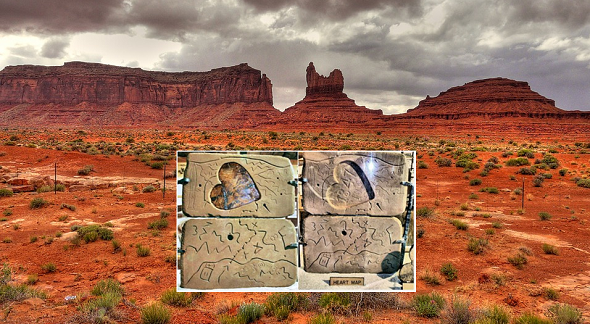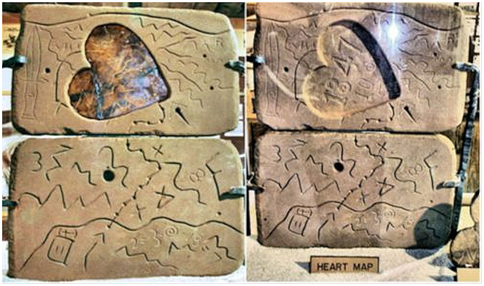The Peralta Stones are a set of engraved stones. Some people believe they indicate the location of a lost gold mine.
Solving a cryptogram introduced on Klausis Krypto Kolumne usually doesn’t earn you money. However, there might be exceptions. The following encrypted messages are said to lead the person who deciphers them to a hidden treasure:
- Beale cryptograms: The most famous encrypted notes allegedly decribing the location of a treasure. In my view the story is a hoax.
- Fenn’s poem: To find the treasure hidden by millionaire Forrest Fenn you need to decipher a poem.
- La Buse cryptogram: Olivier Levasseur (“La Buse”), a pirate in the Indian Ocean, is said to have hidden a treasure, the location of which is described in a pigpen cryptogram.
- Rennes-le-Chateau cryptogram: This encrypted message is well-known since Dan Brown’s novel The Da Vinci Code. In my view it’s a hoax.
- Oak island cryptogram: Oak Island (Nova Scotia) is known for various theories about buried treasures or strange historical artifacts. One of these theories includes a short encrypted text. In my view it’s a hoax.
- Musical cryptogram: There’s a story about a Nazi treasure and a musical cryptogram that leads to it. It’s probably another hoax.
According to the book The Man Who Breoke Purple, master codebreaker William Friedman received many inquiries regarding encrypted treasure descriptions. I wish, these inquiries were available in some archive, but this seems not to be the case.
The Peralta Stones
Thanks to a Facebook comment by Mark Buono I recently learned about another story that fits into the “treasure cryptogram” category – the Peralta Stones.
The Peralta Stones are a set of engraved stones displayed at the Arizona Museum of Natural History in Mesa, AZ. Some people believe the engravings indicate the location of a gold mine or a hidden treasure. Wikipedia gives the following description:
The stones consist of “two red sandstone tablets and a heart-shaped rock made of red quartzite. Each block is approximately 8.25” (~ 21 cm) by 14” (~35.6 cm) and 2” thick, weighing about 25 lbs. Each red stone block is carved with lines and one long line. When the two blocks are placed side by side and the stone heart is inserted the long line has 18 dots pecked into it. This style of map is known as a Post Road Map and it is a style used in Mexico and Spain during the Mexican–American War. Inscribed on the stones is the date 1847, and one stone contains a relief of a heart, which the heart-shaped stone fits perfectly. The heart shape fits neatly in the second stone. The back of the stone that the heart-shaped stone fits into has the outline of a cross carved on the back. The back of the other stone has the word DON carved into it.
[…]
The two red sandstone map pieces are displayed with a third white sandstone of similar size and weight as the red ones. The history of the white stone was cited by an author using the moniker ‘Azmula’. Azmula cites the history in the Superstition Mountain Journal, issue 27 of 2009. He attributes the original citation to M. Kraig Roberts. Mr. Roberts’s article is titled “History of the Chain Of Possession Of The Stone Maps”. The Journal article is a history of the white stone. The white sandstone has a side showing a Priest who is assembling the Peralta Stones to form the map. The reverse side is known as the Horse Map. The Priests Stone contains Spanish text that states that to find the gold you must find the heart. The lower half of the number 8 in the red sandstone map has a small heart carved in the circle.
The cryptogram
Some people interprete the lines and the symbols on the Peralta Stones as a map. Allegedly this map indicates the location of the so-called Lost Dutchman’s Gold Mine. The numbers on the stones are believed by some to be a formula for the map scale.
Some other hypotheses say that the stones don’t lead to a gold mine but to a treasure or a buried vault containing valuable art objects.
Others think the symbols encode a message. Some even claim to have deciphered the message. For instance, the following cleartext was proposed: “Be ready boy, are on a map on Arizona county scale, scale map.” Many other theories exist, but neither a gold mine nor a treasure has never been found.
As I am still new to this topic, I can’t go into detail about all the stories that have been published about the Peralta Stones. If you consult Google, you will find numerous websites about the stones and the theories surrounding them.
There seems to be serious doubt that the Peralta Stones are genuine and that the gold mine (or the treasure or the art vault) really exists. As a skeptic I am generally doubtful about stories like these. For a critical treatise of the Peralta Stones check here. If you have a different opinion or if you have an idea how to decipher the engravings, please let me know.
Follow @KlausSchmeh
Further reading: Does the Voynich manuscript show the solar eclipse of April 15, 1409?
Linkedin: https://www.linkedin.com/groups/13501820
Facebook: https://www.facebook.com/groups/763282653806483/




Kommentare (5)